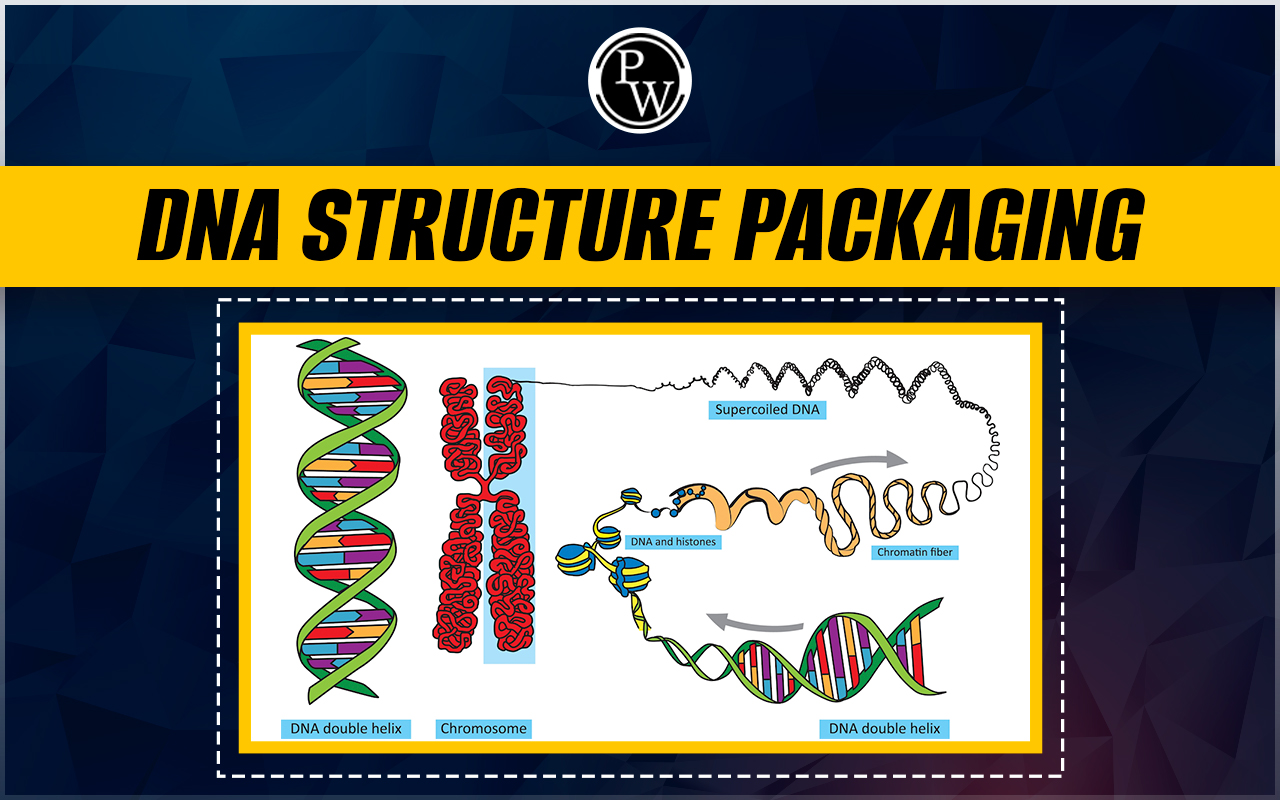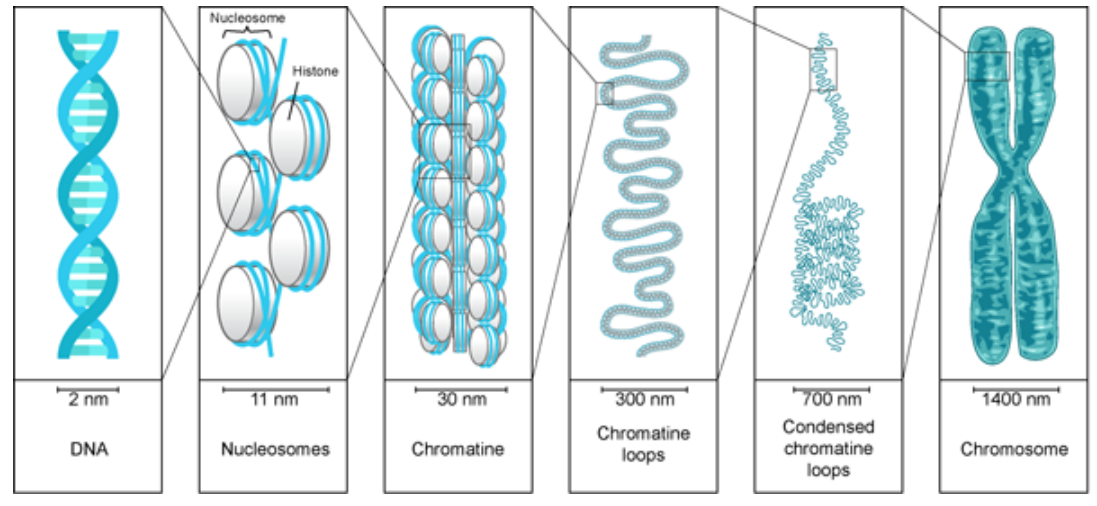

You've found the useful article if you were looking for information about the DNA Structure Packaging .
This article provides an overview of the structure of DNA and its packaging into a compact form. The focus is on histones and nucleosome role in DNA packaging. This page aims to summarise DNA packaging, including any important details, concisely. If you don't have time to read the whole article, it is recommended to at least read the introduction and the important topics.Introduction
All living things have a long DNA molecule (Deoxyribonucleic acid) that retains their genetic information. DNA contains the instructions for the growth and functioning of every living thing. It comprises four nitrogenous bases (adenine, guanine, cytosine, and thymine) ordered in a precise sequence. Watson and Crick proposed DNA's shape. In their view, DNA has a double helical shape with two polynucleotide strands antiparallel. DNA's backbone contains phosphate groups, negatively charged the molecule and forming a double helix. To neutralise this charge, the cell creates histone proteins, which bind to DNA. Histone proteins function in DNA packing. In eukaryotic cells, DNA is housed in structures called chromosomes, which may be found in the nucleus. DNA replication ensures that an organism's distinctive traits and properties are preserved from generation to generation. DNA packing's mechanical properties are essential in the biological system's gene regulation mechanism. Rarely do the properties of condensed DNA match those anticipated of a dilute liquid. When DNA is packed, it takes up less room in a cell. And it facilitates correct chromosomal separation during cell division. Because of how closely the DNA is packed, it only takes a few seconds to turn genes on or off.DNA Structure
DNA has a double helix structure, with two strands of nucleotides (the building blocks of a molecule) that run in opposing directions and are kept together by hydrogen bonds between the nitrogenous bases. Sugar (deoxyribose), phosphate, and one of the four nitrogenous bases make up each nucleotide in DNA (adenine, guanine, cytosine, or thymine). Two hydrogen bonds are always present between adenine and thymine, while three hydrogen bonds are always present between cytosine and guanine. Base pairing describes the specificity and stability provided by the pairing of nitrogenous bases in the DNA double helix. If you imagine the sugar-phosphate backbone of DNA as the sides of a ladder and the nitrogenous base pairs as the rungs, you have a very accurate mental image of the DNA double helix. DNA can reproduce with some degree of conservatism thanks to its structure, protecting its genetic information.Disorders of the Circulatory System
 The nucleotide structure of a DNA molecule comprises the nitrogen bases adenine (A), thymine (T), cytosine (C), and guanine (G). Each A and G is a purine, while each C and T is a pyrimidine.
The DNA helix and the DNA strand are inherently antiparallel. The presence of a hydrogen bond between the strand's two complementary bases is what keeps the strands together. Each strand is coiled in a right-handed helix, with ten nucleotides making up one turn.
With a helix pitch of
3.4 nm
, each strand is very tight. It follows that there is
0.34 nm
of space between two successive base pairs (i.e., hydrogen-bonded bases of opposing strands).
The nucleotide structure of a DNA molecule comprises the nitrogen bases adenine (A), thymine (T), cytosine (C), and guanine (G). Each A and G is a purine, while each C and T is a pyrimidine.
The DNA helix and the DNA strand are inherently antiparallel. The presence of a hydrogen bond between the strand's two complementary bases is what keeps the strands together. Each strand is coiled in a right-handed helix, with ten nucleotides making up one turn.
With a helix pitch of
3.4 nm
, each strand is very tight. It follows that there is
0.34 nm
of space between two successive base pairs (i.e., hydrogen-bonded bases of opposing strands).
Diphtheria: Types, Symptoms, Causes, Treatment
Histones
In eukaryotic cells, the structure and regulation of DNA is mostly controlled by a class of proteins called histones. These proteins are very tiny and have a positive charge. They are the fundamental components of chromatin, the substance that is responsible for the formation of chromosomes. Each histone protein has a core globular domain and an extended "tail" section. The central domain may be changed by a range of chemical processes, including acetylation, methylation, and phosphorylation, whereas the tail region can only be affected by acetylation. These alterations alter how histones interact with DNA, affecting chromatin's structure and how tightly it is packed together. The four core histones are designated as H2A , H2B , H3 , and H4 . An octamer is constructed using two dimers of H3 , H4 , as well as two dimers of H2A , H2B . When a methyl group is attached to histones, the resulting structure becomes more hydrophobic. Because of this, the packaging of the DNA is extremely compact.Characteristics of DNA Structure
DNA's structure is remarkable in numerous respects, contributing to its use as a medium for storing and transferring genetic information:- The DNA strands have been twisted helically, and each individual strand has formed a right-handed coil.
- The two strands of DNA that complement one another run in opposing orientations. This ensures that DNA replication occurs in the same way each time.
- During DNA replication, the sugar-phosphate backbone acts as a template for adding additional nucleotides and providing the structural support necessary for the DNA molecule itself.
- The entire length of a DNA molecule is determined by the sum of the distance that separates two consecutive base pairs and the product of the total number of base pairs.
- 0.34 nanometers to travel the distance between two base pairs.
- Each helix has a pitch of 3.32 nm , and one turn of the helix is composed of around 10 nucleotides.
DNA Packaging
DNA packing refers to the process by which the genetic material that makes up eukaryotic cells is arranged and compressed within the nucleus of those cells. Because the DNA in a single cell can be several meters long, but it still needs to fit inside the constraints of the nucleus, this process is important. DNA packaging is an essential mechanism that enables eukaryotic cells to store and arrange their DNA in a compact and accessible form. It also provides eukaryotic cells a dynamic and flexible way of directing gene expression while protecting the genetic material's integrity. There are three stages involved in the packaging of DNA.- The formation of nucleosomes is the initial step in packing DNA.
- The solenoid fiber stage is the second one in the process of DNA packing.
- Chromosomes, scaffold loops, and chromosomes comprise the third and final order of DNA packing.
 Chromosomes are more compact, higher-order structures formed by further packing nucleosomes to form a
30 nm
fiber. This fiber may then be further coiled and folded to make a more compact version of the chromosome. Cells can restrict the access of the cellular machinery involved in gene expression to the DNA thanks to the structure and compaction of chromatin, which plays an important part in regulating gene expression.
The degree to which chromatin is compacted may alter in response to various signals and situations, enabling cells to regulate gene expression in a dynamic and flexible way. For instance, chromatin can be compacted to block access to DNA and inhibit gene expression. It can also be decompressed to provide access to the DNA, which is necessary for transcription and other activities.
Chromosomes are more compact, higher-order structures formed by further packing nucleosomes to form a
30 nm
fiber. This fiber may then be further coiled and folded to make a more compact version of the chromosome. Cells can restrict the access of the cellular machinery involved in gene expression to the DNA thanks to the structure and compaction of chromatin, which plays an important part in regulating gene expression.
The degree to which chromatin is compacted may alter in response to various signals and situations, enabling cells to regulate gene expression in a dynamic and flexible way. For instance, chromatin can be compacted to block access to DNA and inhibit gene expression. It can also be decompressed to provide access to the DNA, which is necessary for transcription and other activities.
Difference Between Prokaryotic And Eukaryotic Replication
Role of Nucleosomes in DNA Packaging
In eukaryotic cells, the nucleosome is the fundamental building block for packaging DNA. They are made up of around 147 base pairs of DNA that are coiled around a histone protein octamer. This histone protein octamer is composed of two copies of each of the four distinct histone proteins ( H2A , H2B , H3 , and H4 ). Nucleosomes play an essential part in the packaging of DNA since they not only provide a method for arranging and compacting DNA but also make it possible to regulate gene expression. This makes nucleosomes an essential component. Wrapping DNA around histone proteins results in a more ordered and compact structure. This allows cells to use the limited space within the nucleus more efficiently.Do Corn Reproduce Sexually Or Asexually?
Nucleosomes, in addition to their role in arranging DNA, are very important in controlling gene expression. It is possible for the histone proteins that are contained within nucleosomes to undergo a variety of chemical alterations, including acetylation, methylation, and phosphorylation. These modifications can affect the interactions that occur between histones and DNA. The shape and compaction of chromatin can be altered as a result of these alterations, which can either make DNA more or less accessible to the cellular machinery that is involved in gene expression.Difference Between Vitamin D and Vitamin D3
For instance, acetylation of histones can relax the structure of chromatin, which in turn makes the DNA more accessible to the cellular machinery involved in gene expression and makes it possible for genes to be activated. On the other hand, methylation of histones can cause chromatin structure to become more compact, which in turn reduces DNA's accessibility and suppresses gene expression.Related Links -
Importance of DNA Packaging
There are various reasons why DNA packaging is so important:- Gene Regulation : The packaging of DNA is an important factor in determining how genes are expressed. The degree to which chromatin is compacted can determine how easily DNA can be accessed by the cellular machinery involved in the gene expression process. This allows cells to switch genes on and off in response to various stimuli and environmental factors.
- DNA Protection : When DNA is packaged into chromatin, it helps to keep the DNA from being damaged and also helps to prevent the DNA from being lost. Cells may protect their DNA from damage and guarantee that the genetic information is reliably handed down from one generation of cells to the next by compressing DNA into a more manageable and well-organized structure. This process is known as DNA amplification.
- Cell Division : Condensation of chromosomes is an essential part of DNA packing. During the process of cell division, chromatin organises itself into chromosomes, which can be seen under a microscope and then be segregated into their respective daughter cells by the activity of the mitotic spindle.
- Space Management : Eukaryotic cells have limited space in their nuclei, and DNA packing is one way these cells manage this space. Cells can guarantee that all their genetic information is kept within the nucleus by compressing their DNA into a more ordered and space efficient form. This ensures that genes can express and operate to their full potential.
- Evolution : Alterations in the structure and compaction of chromatin can lead to alterations in gene expression, which can, in turn, promote evolutionary change and the formation of new species. DNA packaging provides a flexible mechanism of adaptation to changing environmental conditions. This is accomplished by enabling cells to control their genes' expression.
Related Links -
DNA Structure Packaging <span style=
What is DNA methylation?
DNA methylation involves adding methyl groups to various sections of the genetic material. By changing the structure of chromatin and rendering it more inaccessible to the cellular machinery necessary for gene expression, DNA methylation can play a function in regulating gene expression.
What is chromatin, and how does it contribute to the packing of DNA?
Chromatin is a structure created due to DNA interacting with histone proteins and other proteins that are not histone proteins. Chromatin offers a mechanism of arranging and compacting DNA, which enables cells to handle the limited space available within the nucleus. Chromatin is found in all cells. Chromatin also plays an important part in the regulation of gene expression. This is because the compaction of chromatin may affect how easily DNA is accessible to the cellular machinery involved in gene expression.
What is a nucleosome? How does it fit into the process of DNA packaging?
In eukaryotic cells, the fundamental building block for the packing of DNA is called a nucleosome. The structure comprises around 147 base pairs of DNA that are coiled around an octamer of histone protein. The histone proteins contained within nucleosomes can be altered to change the structure and compaction of chromatin as well as regulate access to DNA. As a result, nucleosomes serve as a method for organising and compacting DNA and play an important part in regulating gene expression.
Why is DNA packing important?
The packaging of DNA is essential for several reasons, including the control of genes, the preservation of DNA, the management of space, cell division, and evolutionary processes. Cells can guarantee that all their genetic information is kept within the nucleus by compressing their DNA into a more ordered and space efficient form. This ensures that genes can express and operate to their full potential. In addition, DNA packaging offers a dynamic and adaptable method of managing access to the genetic information contained in DNA and regulating the expression of genes.
What is euchromatin?
The type of chromatin known as euchromatin is characterised by less dense packing of its constituent proteins and is linked to dynamic gene expression. The structure of euchromatin is less dense and more accessible than that of heterochromatin, which enables the cell's machinery to access the DNA inside it and transcribe it into RNA.
🔥 Trending Blogs
Talk to a counsellorHave doubts? Our support team will be happy to assist you!

Check out these Related Articles
Free Learning Resources
PW Books
Notes (Class 10-12)
PW Study Materials
Notes (Class 6-9)
Ncert Solutions
Govt Exams
Class 6th to 12th Online Courses
Govt Job Exams Courses
UPSC Coaching
Defence Exam Coaching
Gate Exam Coaching
Other Exams
Know about Physics Wallah
Physics Wallah is an Indian edtech platform that provides accessible & comprehensive learning experiences to students from Class 6th to postgraduate level. We also provide extensive NCERT solutions, sample paper, NEET, JEE Mains, BITSAT previous year papers & more such resources to students. Physics Wallah also caters to over 3.5 million registered students and over 78 lakh+ Youtube subscribers with 4.8 rating on its app.
We Stand Out because
We provide students with intensive courses with India’s qualified & experienced faculties & mentors. PW strives to make the learning experience comprehensive and accessible for students of all sections of society. We believe in empowering every single student who couldn't dream of a good career in engineering and medical field earlier.
Our Key Focus Areas
Physics Wallah's main focus is to make the learning experience as economical as possible for all students. With our affordable courses like Lakshya, Udaan and Arjuna and many others, we have been able to provide a platform for lakhs of aspirants. From providing Chemistry, Maths, Physics formula to giving e-books of eminent authors like RD Sharma, RS Aggarwal and Lakhmir Singh, PW focuses on every single student's need for preparation.
What Makes Us Different
Physics Wallah strives to develop a comprehensive pedagogical structure for students, where they get a state-of-the-art learning experience with study material and resources. Apart from catering students preparing for JEE Mains and NEET, PW also provides study material for each state board like Uttar Pradesh, Bihar, and others
Copyright © 2025 Physicswallah Limited All rights reserved.
Get App











